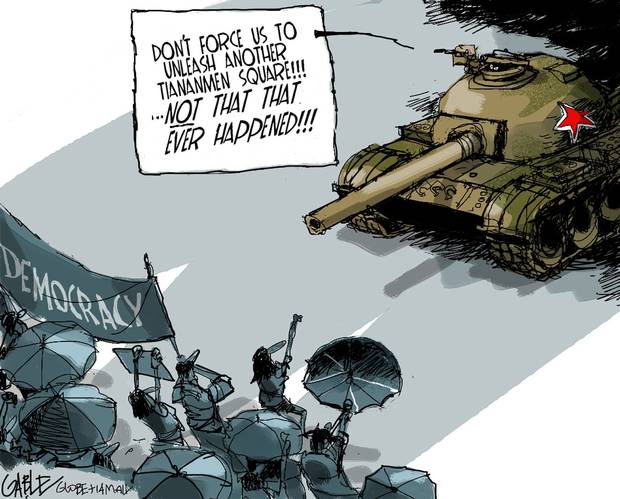Follow The Globe’s Nathan Vanderklippe (@nvanderklippe) in Hong Kong as police mobilize and protesters threaten action in the “Umbrella Revolution.” Get caught up first with The Globe’s simple primer on the protests.
There was singing and cheering on the streets of Hong Kong again Wednesday, as tens of thousands took to the streets for a fifth day to demand better treatment from Beijing.
But the city’s peaceful protest, with its humble umbrellas as talismans and its armies of volunteers removing trash and recycling, now faces a potentially dangerous confrontation with mainland authorities, who toughened their stand Wednesday even as protest leaders planned their own escalation in tactics.
In a prominent editorial, China’s state-run People’s Daily called for police to restore order and disperse what it called an unlawful assembly that has brought hundreds of thousands of students, housewives, professionals and retired people to occupy downtown roads.
Hong Kong’s demonstrators have demanded changes to Beijing’s proposal for a restricted form of democracy in the city’s 2017 elections. But the People’s Daily said China’s electoral proposal is legally valid and “unshakeable.” The newspaper is often a more sober voice of the Chinese Communist Party, and therefore considered a credible approximation of the way top leaders are thinking.
Social-media users were quick to pick out the echoes of the April 26, 1989, editorial in the People’s Daily that helped spark the protests leading to the bloody military attack on students massed around Tiananmen Square.
In Hong Kong, meanwhile, buses and paddy wagons were seen parked outside police headquarters on Wednesday night. Asked if police were expecting trouble, one officer said: “No trouble, just peace.”
Leaders of Occupy Central gave their blessing to threats by student groups to occupy government buildings if Beijing does not reply to their demands by Thursday.
“I hope that people can understand why people have to keep on escalating the actions – it’s because the government is so irresponsive, so irresponsible,” Chan Kin-man, one of the three leaders of the Occupy movement, said in an interview.
Pressed on whether he now advocates taking over the central government’s principal building, which is already surrounded by protesters, he said: “if the government doesn’t respond, why not? As long as it’s peaceful, as long as no one gets hurt.”
It’s not clear whether that would be possible. Such a move would mark a major departure from images of students sitting in streets, and has stirred worries that it would be met by a strong-fisted police response. It was an earlier attempt to move into government buildings that prompted clouds of police tear gas and pepper spray on Sunday.
At the same time, Hong Kong police have in recent days been nearly invisible around protest sites, with government leaders adopting a deliberately low-key strategy – even allowing protesters to attend a flag-raising on Wednesday’s Chinese National Day ceremonies, in a rare step. The strategy has successfully prevented conflict, and analysts suggest authorities are prepared to let the protests continue through this week, which has two holiday days that limit the disruption to the city.
Mr. Chan argued a non-violent takeover remains possible, pointing to the virtually complete lack of disorder among crowds that, on Tuesday night, filled a 12-lane road for kilometres, remaining even in the midst of a fierce thunderstorm with heavy rain.
“Even I myself could not believe people could take on such a major role without creating physical confrontations. So let’s keep our imaginations going,” Mr. Chan said.
Yet a takeover of government buildings would likely damage public perceptions of protesters as polite and highly civilized. It may also provoke more direct conflict.
“There is a danger that things may get out of hand. And that the government may be actually trying to engineer this,” said Willy Lam, an adjunct professor at Chinese University of Hong Kong.
But the situation is a difficult one for Hong Kong authorities, and their masters in Beijing. The city’s police force numbers roughly 30,000, and is now routinely outnumbered by protesters, who have already “demonstrated that they are not afraid of tear gas,” Prof. Lam said.
“The deployment of the PLA [People’s Liberation Army] garrison is a last resort. But this is one option. And the second option is to make a few concessions.”
The most visible would be to force the departure of Leung Chun-ying, the unpopular sitting chief executive who has become the focus of protesters’ anger. But he has said stepping down would do little to advance democratic reforms. And Beijing has avoided any move that would show it giving in to protests, out of fear that it will be seen as weak in other places where it holds a more tenuous grasp on authority, such as Tibet and Xinjiang.
Beijing could also quietly bring in police from neighbouring mainland provinces, who speak the same language although are unlikely to possess equal training.
Those on the streets, however, say only the exit of Mr. Leung will satisfy them.
“If he doesn’t step down, I don’t see how Beijing can really listen to the voice of Hong Kong people. It is utmost for him to step down first,” Mr. Chan said.
In the meantime, with more people pouring in to the streets Wednesday evening and neither side showing any openness to compromise, Mr. Chan pledged to “keep fighting. We won’t give up our fight for democracy.”
NATHAN VANDERKLIPPE
HONG KONG — The Globe and Mail
Published Wednesday, Oct. 01 2014, 3:27 AM EDT
Last updated Wednesday, Oct. 01 2014, 9:25 AM EDT

